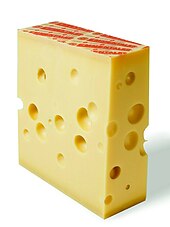
Rennet is a complex set of enzymes produced in the stomachs of ruminant mammals. Chymosin, its key component, is a protease enzyme that curdles the casein in milk. In addition to chymosin, rennet contains other enzymes, such as pepsin and a lipase.

Cottage cheese, also known as curds and whey, is a curdled milk product with a mild flavor and a creamy, heterogenous, soupy texture. It is made from skimmed milk by draining curds but retaining some of the whey and keeping the curds loose. An essential step in the manufacturing process distinguishing cottage cheese from other fresh cheeses is the addition of a "dressing" to the curd grains, usually cream, which is mainly responsible for the taste of the product. Cottage cheese is not aged.

Camembert is a moist, soft, creamy, surface-ripened cow's milk cheese. It was first made in the late 18th century in Camembert, Normandy, in northwest France. It is sometimes compared in look and taste to brie cheese, albeit with a slightly lower butterfat content than brie's typically 20% - 25% by weight.

Colby is a semihard orange cheese made from cow's milk. It is named after the city of Colby, Wisconsin, USA, where it was first developed in 1885 and quickly became popular.

Cheesemaking is the craft of making cheese. The production of cheese, like many other food preservation processes, allows the nutritional and economic value of a food material, in this case milk, to be preserved in concentrated form. Cheesemaking allows the production of the cheese with diverse flavors and consistencies.

Blue cheese is any of a wide range of cheeses made with the addition of cultures of edible molds, which create blue-green spots or veins through the cheese. Blue cheeses vary in taste from very mild to strong, and from slightly sweet to salty or sharp; in colour from pale to dark; and in consistency from liquid or very soft to firm or hard. They may have a distinctive smell, either from the mold or from various specially cultivated bacteria such as Brevibacterium linens.

Acid-set or sour milk cheese is cheese that has been curdled (coagulated) by natural souring, often from lactic acid bacteria, or by the addition of acid. This type of cheese is technologically simple to produce.
The manufacture of Cheddar cheese includes the process of cheddaring, which makes this cheese unique. Cheddar cheese is named for the village of Cheddar in Somerset in South West England where it was originally manufactured. The manufacturing of this cheese has since spread around the world and thus the name has become generically known.
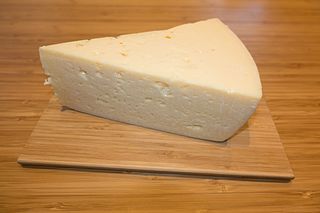
Svecia is a Swedish cheese. It is a semi-hard cow's-milk cheese, with a creamy consistency, light yellow colour, small irregular holes, and a mildly acidic taste. It is produced in wax-covered cylinders weighing 12 to 15 kg each.

Pasta filata is a technique in the manufacture of a family of Italian cheeses also known in English as stretched-curd, pulled-curd, and plastic-curd cheeses. Stretched curd cheeses manufactured using the pasta filata technique undergo a plasticising and kneading treatment of the fresh curd in hot water, which gives the cheese its fibrous structure.

Cheese is a dairy product produced in a wide range of flavors, textures, and forms by coagulation of the milk protein casein. It comprises proteins and fat from milk. During production, milk is usually acidified and either the enzymes of rennet or bacterial enzymes with similar activity are added to cause the casein to coagulate. The solid curds are then separated from the liquid whey and pressed into finished cheese. Some cheeses have aromatic molds on the rind, the outer layer, or throughout.

There are many different types of cheese. Cheeses can be grouped or classified according to criteria such as length of fermentation, texture, methods of production, fat content, animal milk, and country or region of origin. The method most commonly and traditionally used is based on moisture content, which is then further narrowed down by fat content and curing or ripening methods. The criteria may either be used singly or in combination, with no single method being universally used.
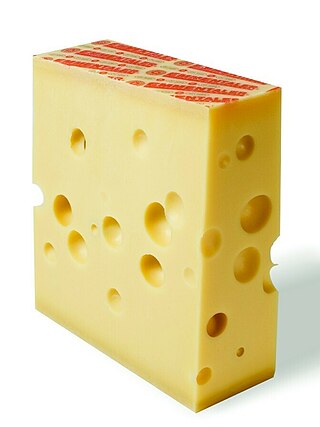
Eyes are the round holes that are a characteristic feature of Swiss-type cheese and some Dutch-type cheeses. The eyes are bubbles of carbon dioxide gas. The gas is produced by various species of bacteria in the cheese.
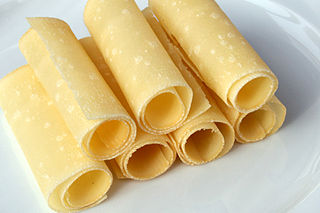
Berner Alpkäse is a hard cheese produced in the Alps of the Bernese Oberland and adjacent areas of Switzerland. It is classified as a Swiss-type or Alpine cheese, and is a spicy, full-fat, raw milk cheese without holes. The cheese is manufactured exclusively with manual labour, usually on a wood fire. An extra-hard variety of Berner Alpkäse, known as Berner Hobelkäse, is aged for at least two years and it is this variety that is most widely available. Both Berner Alpkäse and Berner Hobelkäse are certified as AOPs in Switzerland.

Swiss-type cheeses, also known as Alpine cheeses, are a group of hard or semi-hard cheeses with a distinct character, whose origins lie in the Alps of Europe, although they are now eaten and imitated in most cheesemaking parts of the world. Their distinct character arose from the requirements of cheese made in the summer on high Alpine grasslands, and then transported with the cows down to the valleys in the winter, in the historic culture of Alpine transhumance. Traditionally the cheeses were made in large rounds or "wheels" with a hard rind, and were robust enough for both keeping and transporting.
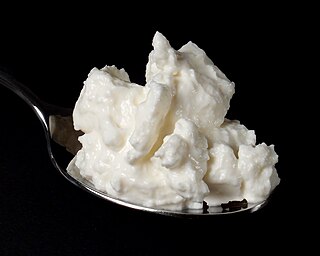
Quark or quarg is a type of fresh dairy product made from milk. The milk is soured, usually by adding lactic acid bacteria cultures, and strained once the desired curdling is achieved. It can be classified as fresh acid-set cheese. Traditional quark can be made without rennet, but in modern dairies small quantities of rennet are typically added. It is soft, white and unaged, and usually has no salt added.

Microbacterium gubbeenense is a Gram-positive, facultatively anaerobic, non-spore-forming and non-motile bacterium from the genus Microbacterium which has been isolated from the surface of a smear-ripened cheese in Ireland.
Enzyme-modified cheese (EMC) is a concentrated cheese flavour ingredient that is produced from cheese by treatment with enzymes such as proteases, lipases and esterases. An incubation period under controlled conditions is required for proper flavor development.These enzymes accelerate and intensify the ripening of cheese, which is normally done with enzymes released by an microbial culture. They may be added to during cheesemaking, after the cheese curds have been pressed, or even after the cheese has been naturally aged. EMCs were first made in the 1970s.



